Alongside one of the salmon recipes in Renee Erickson’s fabulous latest book Sunlight & Breadcrumbs: Making Food with Creativity and Curiosity is a note titled “Tap into Memories” in which she talks of the strong nostalgic connection she has with salmon. Then this, which I love so very much:
For you, nostalgia might taste different: peach pie, fried chicken, or a hearty stew. But don’t give up on chasing those flavors of your youth: They offer powerful motivation in the kitchen.
Don’t give up on chasing those flavors of your youth. Such a valuable thing for us to remember.
It’s an idea that came up in a conversation Renee had with Tom Douglas and Loretta Douglas on Hot Stove Radio late December. In the midst of that podcast conversation, her mom’s mayo-slathered salmon recipe comes up—which leads to talk of being proud of foods we grew up with. That salmon preparation is something she had often as a kid: “we would fish and we would freeze things and we had mayonnaise, which we loved…,” she said, noting that spreading mayo on salmon before cooking was a really easy way to cook their stash of fish. She talks of how sometimes we decide the foods we grew up with aren’t cool enough to cook now, “Of course they’re cool enough!” (If you want to hear that conversation it’s on this episode and starts just shy of 46:00.)
I, too, have a nostalgic connection with salmon. Though we weren’t fishing for salmon and stocking our freezers with it, growing up in the Seattle area meant salmon made regular appearances on our dinner table. I devote a lot of time to honoring my mom in stories and recipes inspired by her collection and my memories of her cooking. Dad deserves his moment too, it’s his whole grilled salmon that’s source of my nostalgia, recounted here with reflections and a recipe. (Sometimes “retro” and “timeless” are interchangeable, grilled whole salmon an ideal example.) Sharing and re-creating that preparation—which he always winged, I know of no recipe he worked from—connects me with my amazing dad (gone a few decades now), brings clearly to mind the back patio at our house in Edmonds where I grew up, and helps me remember friends and occasions associated with times he served his signature fish. Priceless.
I initially started this post with my first newsletter, Seafood Savvy, in mind, inspired by that salmon recipe and others in Renee Erickson’s new cookbook.
Then I thought, hmmm…there’s a strong thread of nostalgia and reflections on childhood food experiences with her parents in that book, too (a bit of which I go into in this newsletter). Maybe it’s more of a Long Live the Recipe Box theme, echoing my more recently launched newsletter?
Rather than toss a coin to pick between the two, I decided to try something different. For the first time, I’m sending the same newsletter out to both audiences, since the cross-over with retro seafood was so evident. It’s an experiment: maybe it’ll be the first and the last! We’ll see how it goes.
Nostalgia is a strong driving force for me with my recipe-box focus. I cherish the recipes of my mom’s in her old folder, and I also cherish just the fact of having that collection: what every recipe card and scribbled note and clipped recipe from a box or a newspaper represents about my mom’s life and interests, our family history, the people she knew. So many things. These cherished recipe collections are time capsules, sentimental journeys, memory banks.
And seafood is often at the center of nostalgia for me, stirring up particular memories, delights, experiences from over the years—whether that’s sparked by my own memories and family history, or reflecting on an era that I have only a second-hand nostalgia for. One such example: I was too young to really appreciate all the finer aspects of ocean liner dining when we sailed from Japan to San Francisco when I was a toddler—and countless viewings of An Affair to Remember only reinforced my longing to click my heels together and find myself on a crossing from that golden era of transatlantic travel, dining on lobster cocktail and sole amandine, sipping pink Champagne alongside. Of course there’d be a baked Alaska for dessert!
There’s a whole other kind of ‘retro.’ The kind that might make us wrinkle our nose a bit as we imagine the finished product, unsure if nostalgia transcends the flavor-texture mash-up of, for example, gelatinized or Jell-Oed seafood concoctions. Now, don’t get me wrong. I’m not saying these dishes below might not be delicious. I may just try that Tuna Olive Mousse one day soon. And I’m reminded that friend and colleague (and food historian) Ken Albala recently published The Great Gelatin Revival, which I’ll traipse through soon to see what seafood inspirations he shares there. Whether gelled or not, there do tend to be some older recipes that we look back on for doses of novelty and historical interest more than for recipe suggestions. Though there’s always opportunity for some creative updating, you never know where new ideas are going to come from.
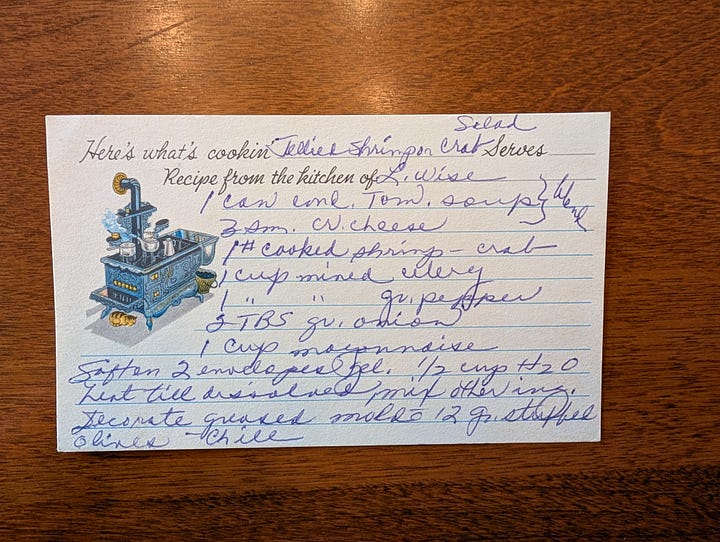
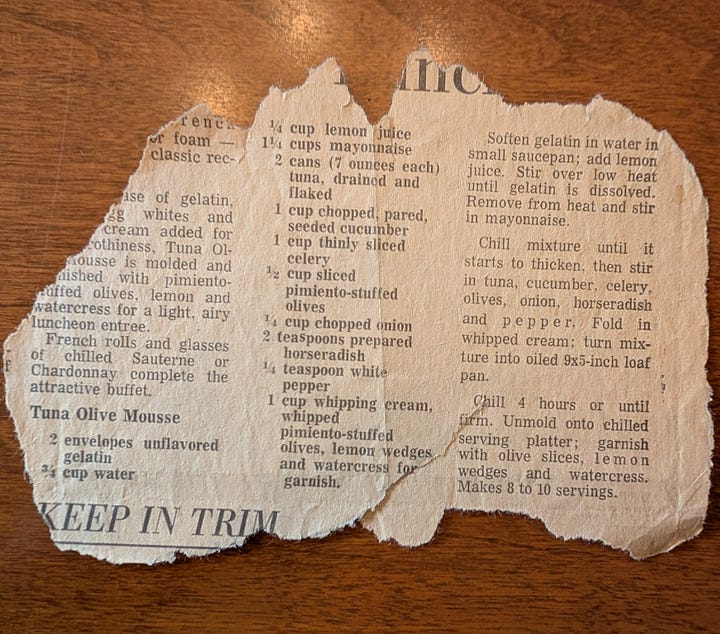
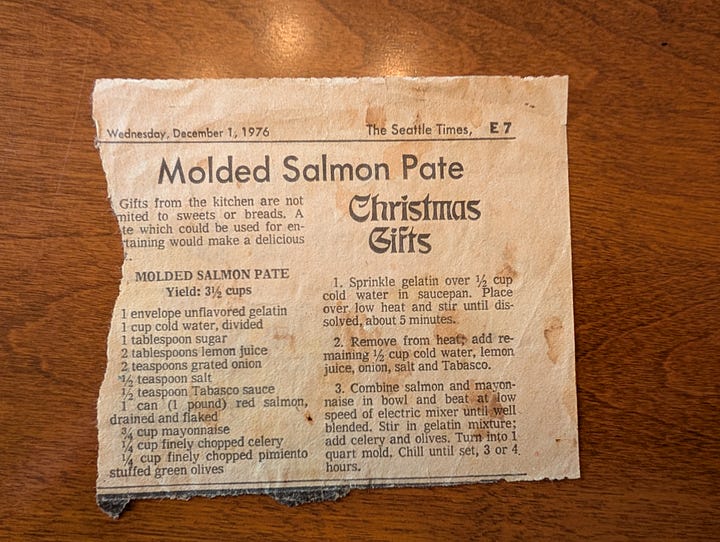
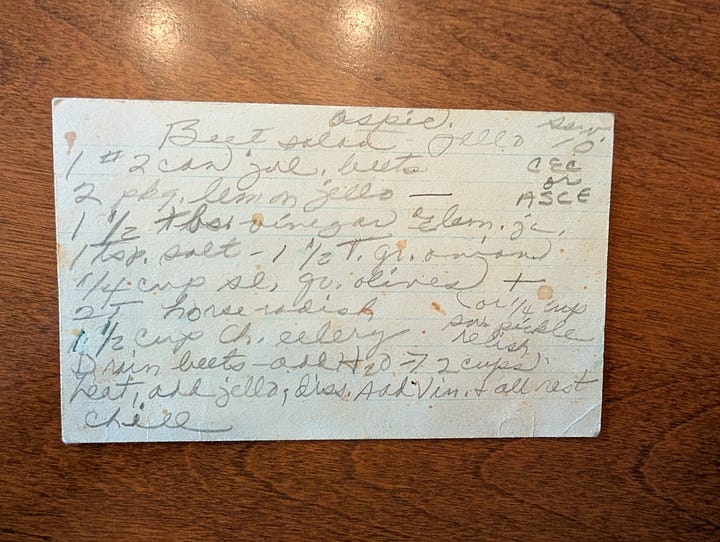
Do any of the retro-seafood references in this newsletter bring to mind any related recipes or memories from your own childhood? If so, please jump down to comments and share a reflection or two. Extra points if it includes some version of tuna casserole—I have that on tap for a future issue!
Flavors of Childhood and Mayo-Slathered Salmon
After Renee’s first two books more focused on her restaurants and culinary inspirations, Sunlight & Breadcrumbs is much more personal—full of stories and recipes that reflect growing up in the Seattle area, her family, her explorations and studies and the unlikely path to buying her first restaurant. This recipe below comes directly from that book, including her recipe headnote that explains her long love of mayonnaise and reflections on her mom’s preparation.
I’m a moderate fan of mayo and use it for a range of things, though hadn’t been on the slathered-on-fish bandwagon until recently. I have yet to slather a side of salmon following Renee’s recipe below, but you can bet I’ll be doing so before long, taking a nod from her mom to do so on the grill. I did, however, recently slather some mayo that I’d mixed with a dab or two of harissa on a couple pieces of cod fillet and baked that for dinner. Yep, it was delicious and will be on repeat.
Within her recipe, Renee sends readers to a note about removing pin bones from the salmon, similar to how I explain it to folks as well. She mentions using clean tweezers; I have a kitchen-dedicated set of small needle-nose pliers on hand for the task. The pin bones are in the upper third or so of the fillet, toward the broader head end. Beginning from the tail end, run your fingers along the fillet up toward the head end and you’ll feel the tips of the pin bones along the surface. Use your clean tweezers or pliers to grab the end of the bone and gently pull it out (tugging too quickly can just pull off the tip of the bone rather than pull the whole bone out).
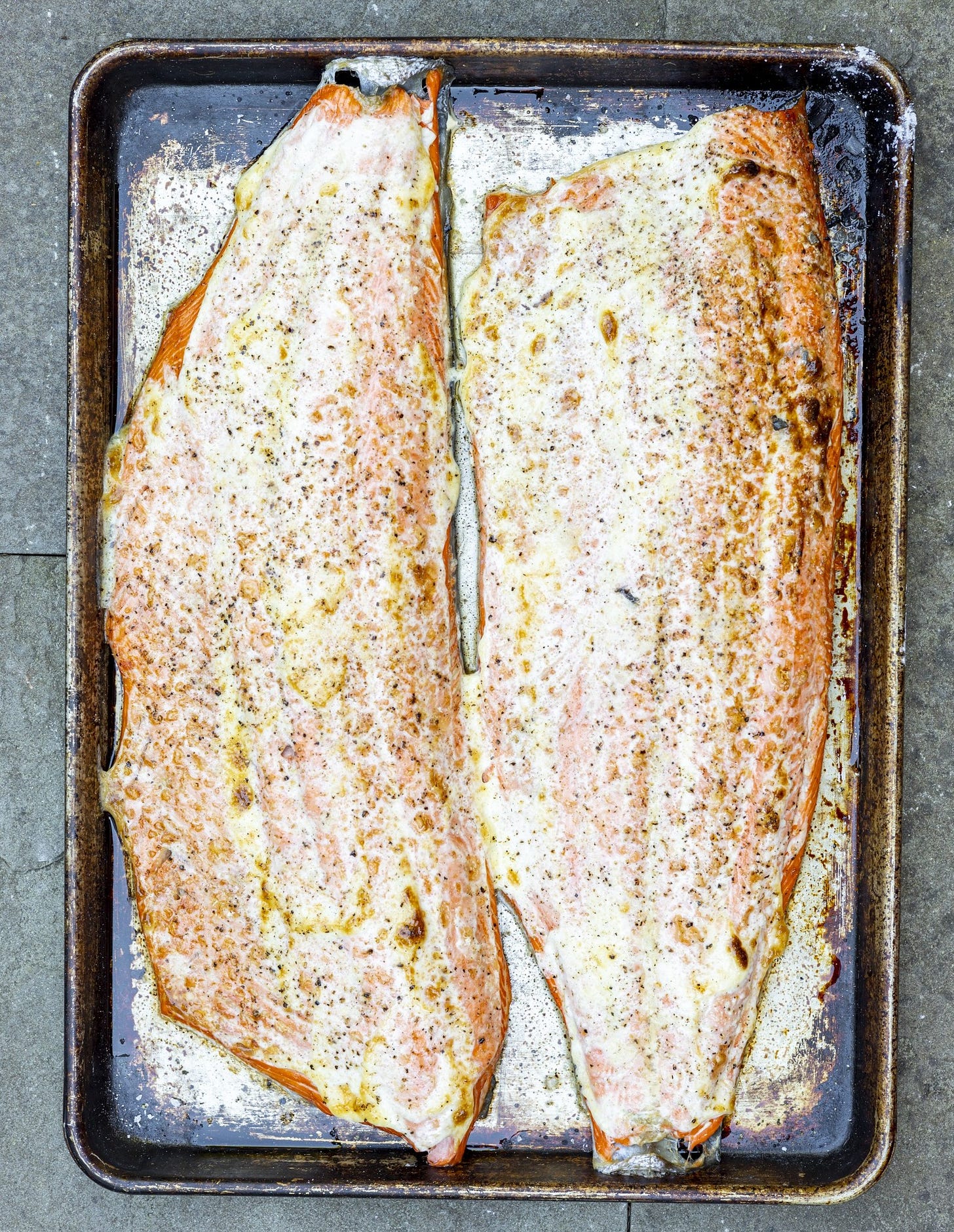
1970s Mom’s Mayo-Slathered Salmon
(from Renee Erickson’s Sunlight & Breadcrumbs, Abrams Books)
Those who know me well know my love for mayonnaise. Of course, I love homemade aioli and other types of mayonnaise, but I also find that commercial mayonnaise, specifically Best Foods, is an MVP in the kitchen. I lavish it into tomato sandwiches, buzz it into green goddess dressing, and here in a throwback move, deploy it as a marinade. The fat in the mayo keeps the salmon moist, and the protein encourages the surface to get all bubbly and brown. My mom mostly grilled salmon on a piece of foil, and you can , too, if you have the setup, but it is also wonderful cooked in a hot oven. When I have time I like serving it with a big herb salad built on a base of Little Gem lettuce, piled up with tons of mint, cilantro, and dill, and drizzled with some olive oil, lemon juice, and salt.
Serves 8 or more as part of a picnic
1/3 cup (75 ml) mayonnaise
1 teaspoon lemon juice
4 pounds (1.8 kg) wild sockeye salmon (about 2 filleted sides), scaled, trimmed, and pin bones removed
1 teaspoon salt
Lots of freshly ground black pepper
Preheat the oven to 400°F (205°C). Line a sturdy sheet pan with parchment paper.
In a small bowl, mix the mayonnaise and lemon juice. Place the fillets on the prepared sheet pan and evenly slather the top side with the mayonnaise mixture. Season with the salt and a generous grinding of black pepper. Place the pan in the oven and cook for about 12 minutes. You want the thickest part just barely firm to the touch. I like a bit of translucence at the center of the fillet if possible. Pull the salmon from the oven and let it rest for about 5 minutes before serving on a pretty platter.
Marinated Shrimp with Sweet Onions
One additional recipe for you that traces back to the 1953 Better Homes & Gardens New Cookbook that was among the few cookbooks my mom cooked from. I briefly referenced this recipe, and its origins, in this Long Live the Recipe Box post about writing recipes in a conversational, narrative style rather than the traditional format with list of ingredients followed by preparation description. Here’s the recipe as I updated and shared it in my latest book, Shellfish.
This will be great as a plated first course for a dinner party or serve the shrimp on a platter for a cocktail party or buffet dinner spread. Since the shrimp cook so quickly, I simmer the spices a bit before adding them so more flavor will be imparted in the quick cook time. Sweet onions can be pretty big, you may not need to use all of yours if it’s extra large; up to you. The shrimp need to marinate for at least 8 hours, and up to 24 hours, so plan accordingly. It makes this a great do-ahead recipe.
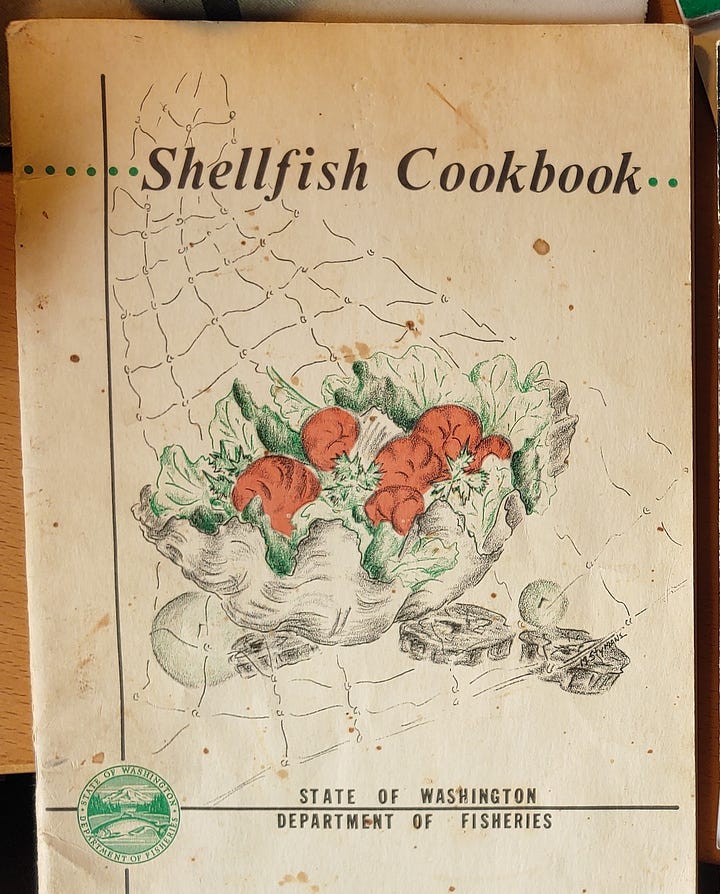
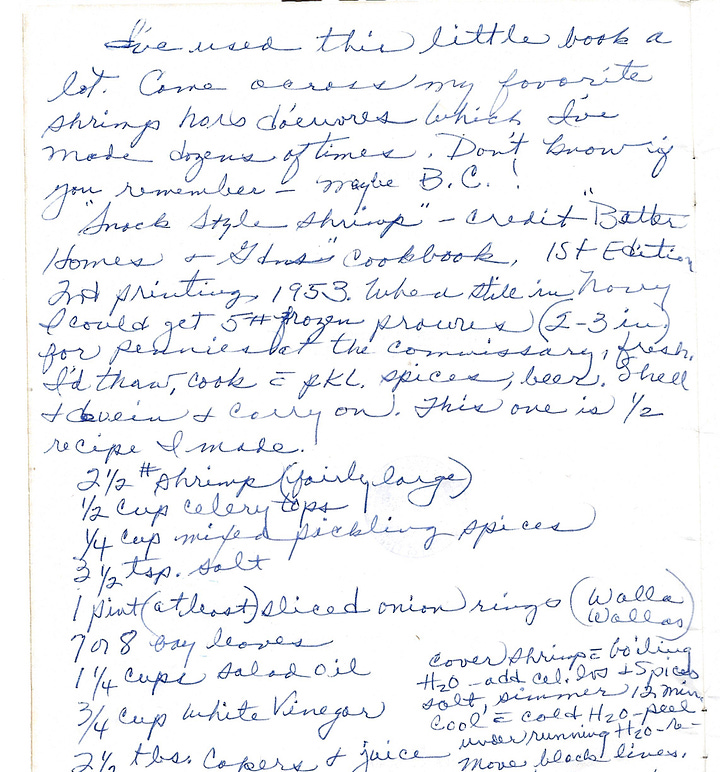
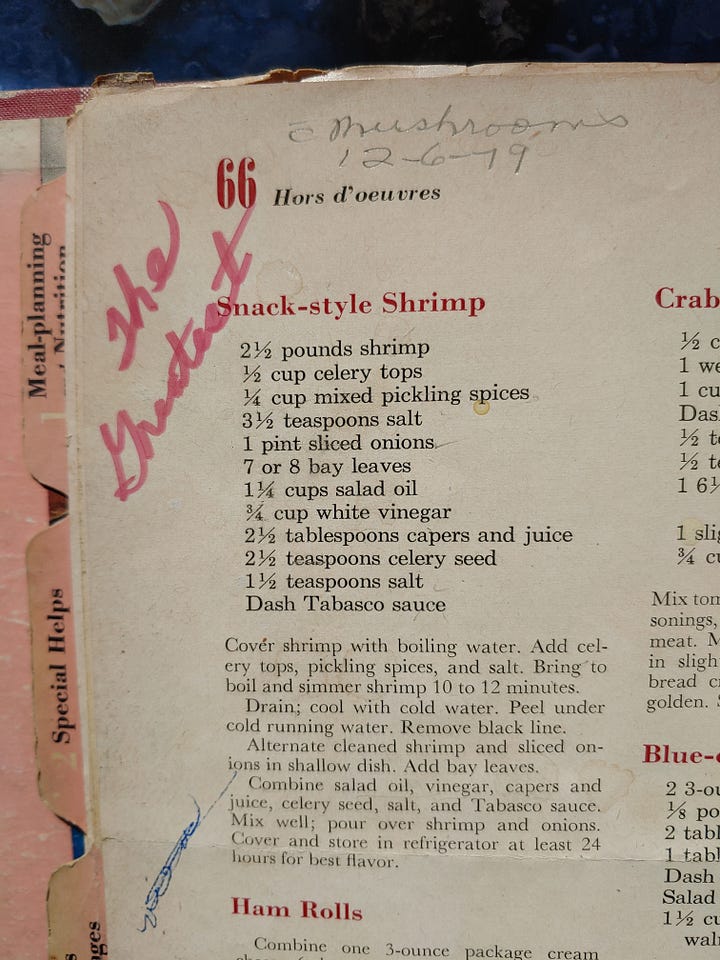
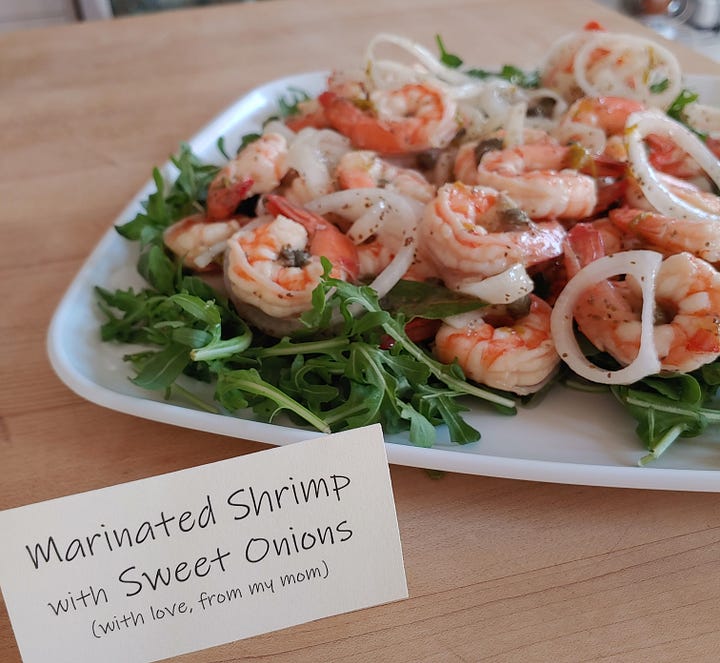
Marinated Shrimp with Sweet Onions
(from Shellfish)
Makes 8 to 10 servings
3 tablespoons pickling spice
1/2 cup moderately packed celery leaves
1 tablespoon plus 1 teaspoon kosher salt, divided
2 pounds medium to large shrimp, preferably shell-on, rinsed
1 small sweet onion (about 12 ounces), cut into 1/4-inch rounds and separated into rings
6 bay leaves, preferably fresh
2/3 cup white wine vinegar
1/2 cup olive oil
2 tablespoons capers and their juice
2 teaspoons celery seed
Tabasco or other hot sauce, to taste
Watercress, frisée, and/or arugula, for serving
Cut a double layer of cheesecloth about 6 inches square. Put the pickling spice in the center, draw up the edges around them and secure the packet with a piece of kitchen string. Put the spice packet, celery leaves, and 1 tablespoon of the salt in a medium pot half filled with water. Bring the water to a boil over medium-high heat and simmer for 10 minutes, pressing the spice packet down into the water now and then if it’s floating at the surface. Carefully add the shrimp and simmer until opaque through the thickest part, (lift one out with a slotted spoon and cut into it to check), 6 to 8 minutes; the water shouldn’t boil vigorously, reduce the heat if needed. Drain the shrimp, discarding the spice packet and celery leaves. When cool enough to handle, peel and devein the shrimp, unless they already have been.
Put the shrimp, onion, and bay leaves in a 9- by 13-inch baking dish or similar deep dish, or in a large resealable plastic bag or other container. Stir together the vinegar, oil, capers and juice, celery seed, remaining 1 teaspoon of salt, and few dashes of Tabasco (or to taste). Pour this evenly over the shrimp, cover or close the container, and refrigerate for at least 8 hours, and up to 24 hours, before serving. Gently stir or toss things around once or twice to ensure even seasoning while they marinate.
To serve, arrange the greens on a serving platter or individual plates. Spoon the shrimp and onion onto the greens with just enough marinade to lightly coat; use a slotted spoon to retrieve any capers from the remaining marinade to scatter over.




My mom and aunts cook (and even bake!) everything by eye or feel and so a huge impetus for my upcoming book was to document their recipes, otherwise they would all be lost when they pass away. Recreating many of their dishes left me feeling more connected to them than ever (even though I was living across the country at the time) nd even led to unlocking some core memories I had totally forgotten about it. So I'm with you - nostalgia is a huge driving force for me too!
This evoked so many memories. Growing up in Alaska we had lots of salmon and halibut and trout, but my parents always did the cooking. I didn't learn how to cook! After I married I learned to love it though and I treasure my parents' handwritten recipes (a few) and the inherited cookbooks...so many.